Very few saltwater fish are as beautiful, graceful, and captivating as the tangs and surgeonfish. They are generally large and boldly colored fish that provide the helpful service of eating naturally occurring algae. However, the desire to keep them in a home aquarium is what drives many of us to set up large tanks, which is why some of the smallest tangs are actually the most popular.
Smallest tangs
Now that you have seen each of the 10 types of tangs in this post, you can tell that these are relatively large saltwater fish that require big tanks to swim in. The larger the tang fish, the larger the tank you need to meet their care requirements. If you don’t have a big tank or don’t plan on having a big tank, the best strategy might be to select one of the smallest tangs to care for in your tank.
The smallest tangs (when fully grown) will need less space to swim and are suitable to be kept in moderately smaller tanks.
Here is a list of the smallest tangs as fully-grown adult fish:
- Bristletooth Tomini Tang, with 6-inches as a fully-grown adult, is the smallest tang fish
- SquareTail Bristletooth Tang: 6.5 inches
- Yellow Eye Kole: Fully grown adult size: 7-inches
- Two-spot bristle tooth: 8 inches
- Yellow tang: 8 inches
- Convict tang: 8 inches
- Mimic tang: 8 inches
What is the smallest tang fish?
All tangs start out small, and the popular Blue Hippo Tang can sometimes be purchased at sizes less than two inches, but the Bristletooth Tomini Tang is the smallest tang fish because it will grow to about 15.2 cm in length, or 6-inches as an adult, making it the smallest tang fish that you will commonly encounter in the aquarium world.
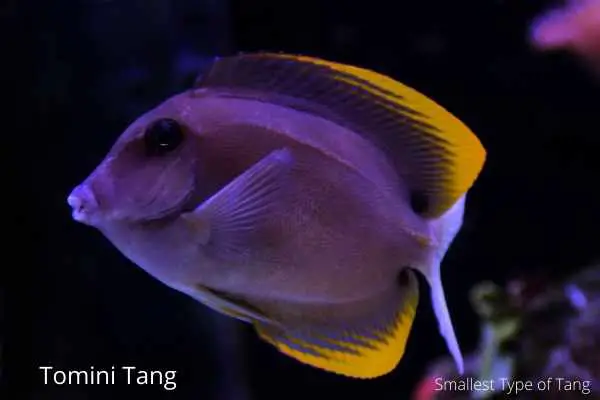
Minimum tank size for the smallest tangs
The minimum tank size to keep the smallest tangs (Tomini, SquareTail, Yellow Eye Kole, Two-spot Bristletooth) is 75-gallons.
| Smallest Tang Species | Size as Fully-grown Adult | Minimum Tank Size |
| Bristletooth Tomini Tang | 6-inches (15.2 cm) | 75-gallons (283.9 liters) |
| Squaretail Bristletooth | 6.5-inches (16.5 cm) | 75-gallons (283.9 liters) |
| Yellow Eye Kole | 7-inches (17.8 cm) | 75-gallons (283.9 liters) |
| Two-spot Bristletooth | 8-inches (20.3 cm) | 75-gallons (283.9 liters) |
| Yellow tang | 8-inches (20.3 cm) | 90-gallons (340.7 liters) |
| Convict Tang | 8-inches (20.3 cm) | 90-gallons (340.7 liters) |
| Mimic tang | 8-inches (20.3 cm) | 90-gallons (340 liters) |
See what other saltwater fish are ideally suited for a 75-gallon tank here.
How big do dwarf tangs get?
The smallest tang fish species, the Tomini Tang, will be 6-inches in total length as an adult and needs a tank at least 75-gallons in volume to be healthy. But while there are full-sized Angelfish, like Majestic and French, and Dwarf Angelfish and Lionfish, there is no such thing as a dwarf tang.
Tang Sizes
The smallest tangs grow to about 6 to 6.5 inches in length as adults, while the largest tangs can be 24 inches or larger. Here is a table that reflects the sizes of some of the most common tang types:
| Adult Tang Size | Types | |||||
| 6 to 7 inches | Tomini | Kole | Squaretail Bristletooth | |||
| 8 inches | Yellow | Convict | Two-spot Bristletooth | Powder Brown | White Cheek | Mimic |
| 9 inches | Gem | Achilles | Powder Blue | Blue Caribbean | ||
| 10-11 inches | Regal Blue | Purple | Chevron | |||
| 12 inches + | Clown | Scopas | Naso + Blonde Naso | Orange Shoulder | Sohal | |
| 12 inches + (continued) | Desjardins | Sailfin | Taminglii | Unicorn |
Affordable tang types
Saltwater fish prices have gotten pretty expensive, over the past few months, as the COVID pandemic-related expenses have really taken a toll on the supply chain that our hobby depends on. Here are three tips to score a saltwater tang at an affordable price:
- Keep a list of a few tang options you’d be happy with an wait for a sale
- Visit popular forums to find the retailers hobbyists recommend most
- Don’t be afraid to check out Petco, or other large chains which are often able to leverage their scale to secure competitive pricing
The most affordable tang types are:
- Convict
- Orange Shoulder Tang
- Sailfin
- Tomini
- Blue Caribbean
- Mimic
Retrieved by online search on Dec 19, 2021
Bristletooth tangs
Some of the most popular tangs you will encounter in the aquarium hobby belong to the Bristletooth family. These fish share the common trait of having a series of teeth on the inside of their mouths that helps them rasp algal films from rocks and glass, helping make them particularly effective at eating algae that grow in the tank.
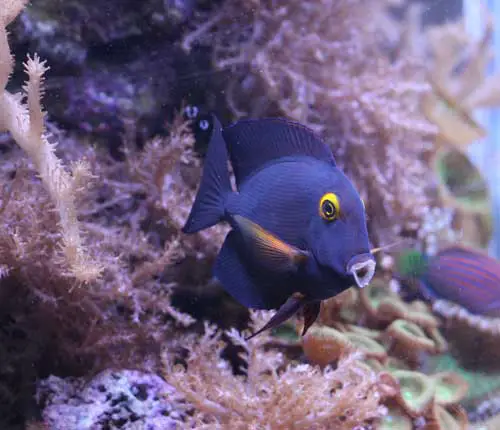
This group of tangs also represents a few of the smallest of all the tang types, which is another reason for their popularity.
The best Bristletooth tangs that you will see in the aquarium hobby are:
- Kole tang
- Tomini tang
- Squaretail Bristletooth
- Two-spot Bristletooth
- Chevron
Kole tang
A great algae-eater, the bristle tooth Kole tang has a gorgeous but sometimes subtle purple-brown coloration, with stripes, spots, and an eye ringed in yellow.
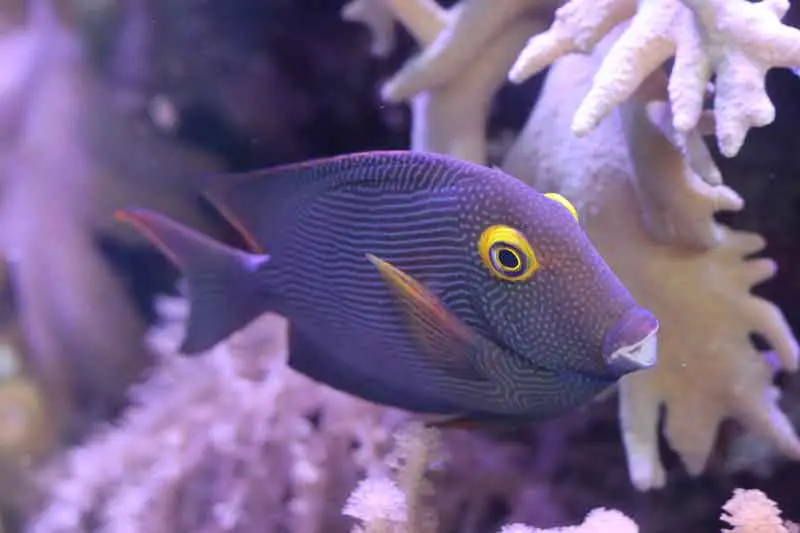
They are one of the best algae-eating saltwater fish you can find and are all-around great to have in a tank because they will help you get rid of green hair algae and other problem algae.
Zebrasoma tangs
The Zebrasoma genus of tangs is a medium-sized group of extremely popular fish because of their vibrant colorations and relative hardiness. The seven species of Zebrasoma tangs share similar round or discoid shapes, a long snout (great for picking algae out of crevices), a large dorsal fin (which is why several carry the ‘sailfin’ monicker), and a single scalpel-like spine on their tail.
The seven types of Zebrasoma tangs are:
- Yellow tang
- Purple tang
- Gem tang
- Sailfin tang
- Dejardini Sailfin
- Black
- Scopas
The largest of the Zebrasoma tangs is the Dejardins Sailfin, which will grow to be about 16-inches as a fully-grown adult. The smallest of the Zebrasoma tangs is the Yellow tang, which will be about half the size of a Dejardins, as an adult, at 8-inches.
Yellow tang
At this point, you may be wondering if the people who have named tangs are not that original. The yellow tang is another popular species. There has been both good and bad news about them lately–the bad news is that it has become a lot more difficult to import them due to fishing regulations in Hawaii.

The good news is that they are one of the few tang species that have been raised in captivity. They are also one of the smallest tangs available (a bit larger than the Tomini Tang) and require ~90-gallons of swimming space, at a minimum.
Learn all about yellow tangs here.
Purple tang
Another cleverly named and gorgeous tang species is the Purple tang, a close cousin to the Yellow listed above. Zebrasoma xanthurum is the Latin genus and species. They are one of the most colourful saltwater fish on this list, have similar care needs as the rest of the surgeonfishes here, and are in the upper-middle-range in terms of cost.

Learn more about Purple tang fish here.
Sailfin tang
The sailfin tang is known for its beautiful and complex color patterns and its large dorsal fin.
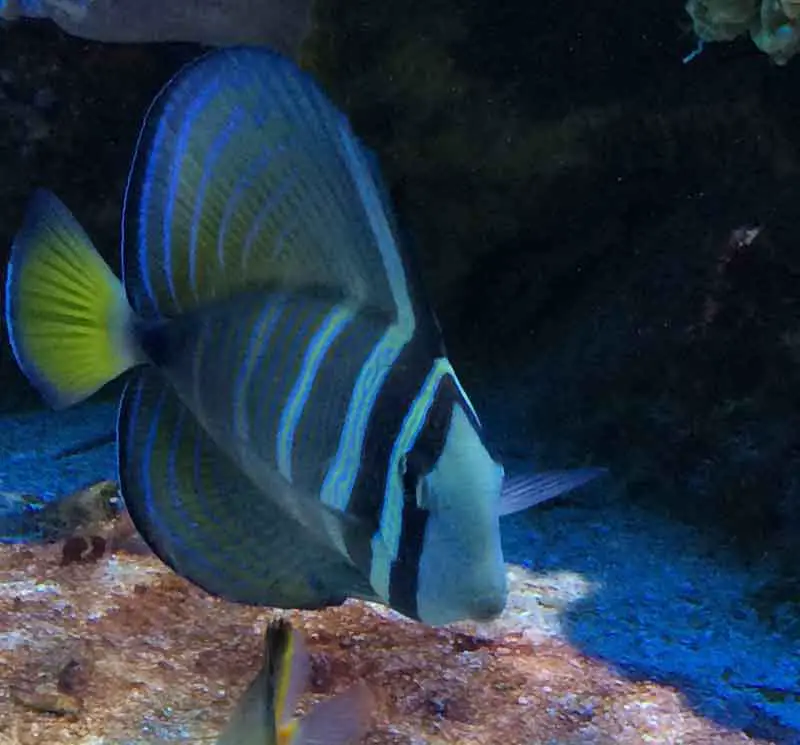
Dive deeper to learn about sailfin tangs here.
Gem tang
The gem tang may require you to own a precious stone-producing mine, but they are absolute stunners.
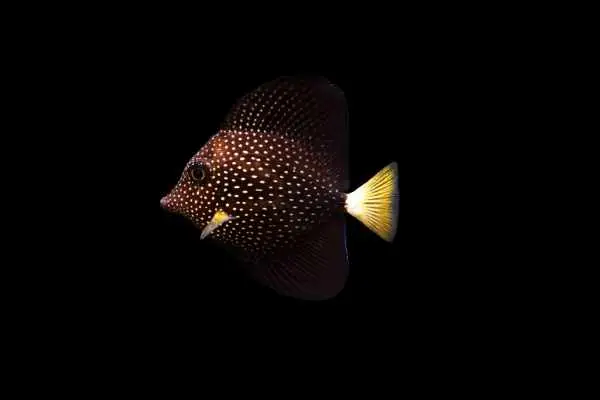
Learn more about caring for the gem tang here.
Desjardini Tang
Sometimes confused for the other Sailfin Tang in this genus, the Desjardini tang grows up quite large (16 inches) and requires a 180-gallon tank to be happy.
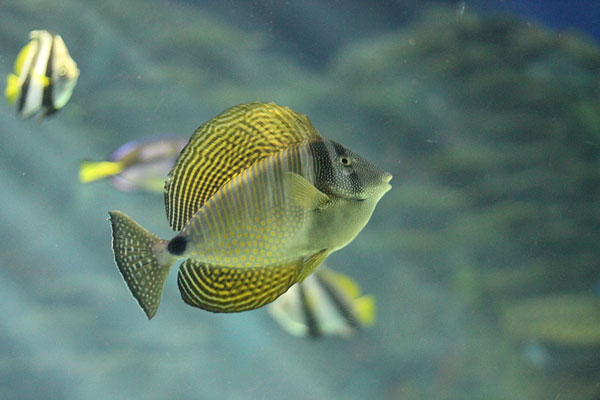
Even though the grow to be quite large, and therefore require a large tank, they are popular due to their appetite for bubble algae, one of the scourges of the aquarium hobby.
The Regal Blue Tang: in a league of its own
Of course, the Hollywood superstar of the Saltwater Fish world is Dory, Paracanthurus hepatus, or the Regal Blue Tang (sometimes called a Blue Hippo Tang). Dory belongs to the Genus Paracanthurus.
Regal BlueTang (Hippo or Pallete Surgeonfish)
Perhaps the most famous of the saltwater tang species is the blue tang, also called the regal tang or hippo tang. One look and you probably FIND why it is so famous.
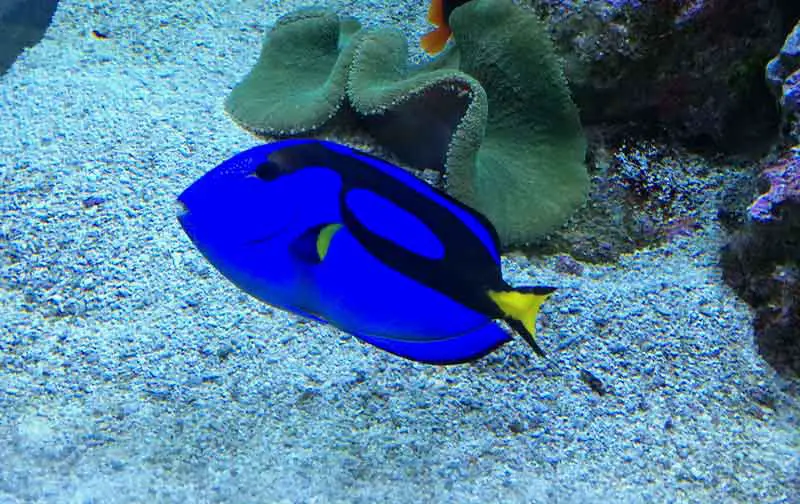
Learn more about caring for the blue tang here.
Acanthurus tangs
The Acanthurus genus has the largest number of individual tang species that you will find in an aquarium.
Here is a list of the most popular Acanthurus tangs for a reef tank aquarium:
- Clown tang
- Orange shoulder
- Sohal
- Mimic
- Powder brown
- Powder blue
- Convict
- Achilles
- Blue Caribbean
- White cheek
Orange shoulder tang
Back to the relatively straightforward naming conventions, the Orange shoulder tangs have…you guessed it…the color orange on their sides. I guess the creativity here was used up inventing an anatomical structure that doesn’t really exist.
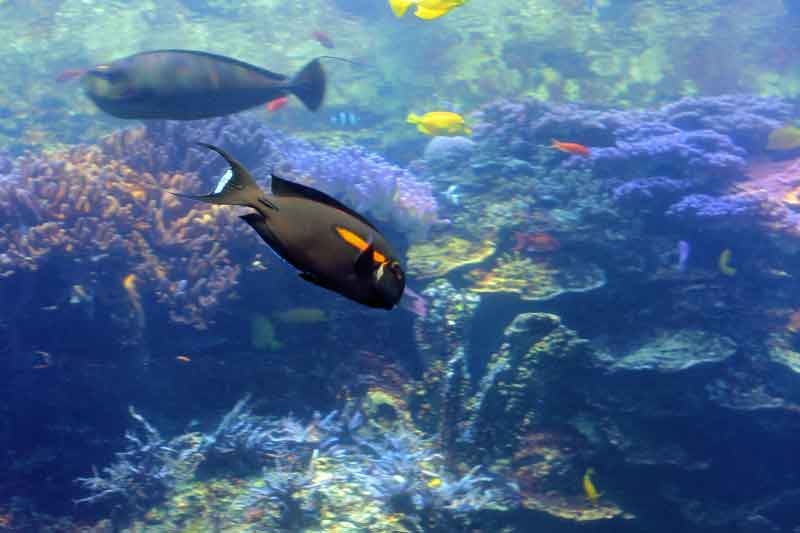
But that doesn’t mean they aren’t fantastic fish.
If you’re interested in the orange shoulder tang, you can dive deeper here.
Powder brown tang
It’s hard to make brown look this good–but check out the Powder brown tang. Stunning, right? They are somewhat prone to ich infections.
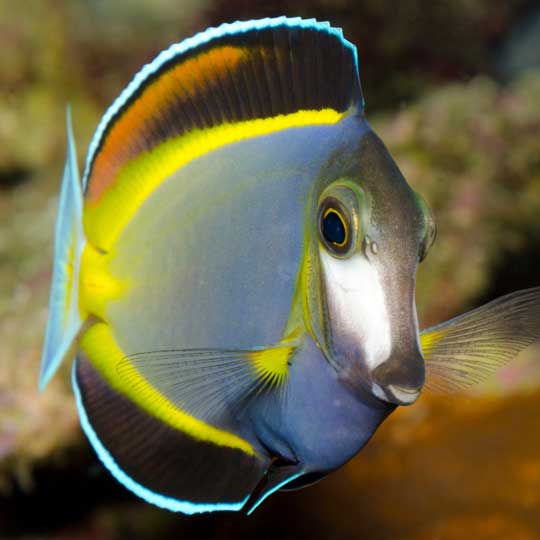
Learn more about the powder brown tang here.
Clown Tang
The blue and yellow tangs were historically my favorite saltwater aquarium fish, but the more I see the clown tang, the more I fall in love. Take a look. They are gorgeous!

Read up on how to care for the clown tang.
Doctorfish
The doctorfish didn’t go to 8 years of medical sch9ol to be called Misterfish, thank you very much. They have a subtle beauty and grace that makes the largest tanks pop with personality.

Doctorfish in the house.
Mimic Tang
As a juvenile, this fish is disguised to look like a Lemonpeel Angelfish. As an adult, the colors morph to a darker, mottled look, but it is still a great tang type for a saltwater tank.

Learn more about the Mimic Tang
Sohal tang
A gorgeous fish, undoubtedly, but best suited for some of the largest saltwater tanks, the Sohal tang adds elegance, beauty and graceful swimming.
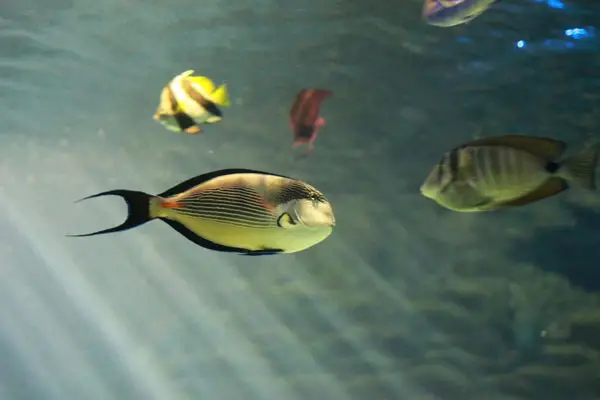
Naso Tangs are some of the largest that you will encounter in an aquarium
The Naso genus has some of the most gorgeous tangs of all, but they are so big that they are only able to be kept in the largest aquariums (180 gallons or larger). The Vlamgii and Unicorn Tangs can grow to over Two Feet in Length…that’s 24-inches! Can you imagine trying to keep a fish this large in a standard 4-foot tank?
- Naso
- Blonde Naso
- Vlamingii
- Unicorn
Nutrition and feeding
All of the different types of tangs listed here are require algae to be healthy. They will spend the majority of the day swimming around your tank and nipping at the live rock, glass, and any other surfaces in your tank to consume the algae present on those surfaces. But you should not rely on that alone as the only source of veggie-derived nutrition.
Spirulina or other algae-based foods, like Formula Two, Seaweed Extreme, or even Spirulina-supplemented brine shrimp will help keep your fish happy and healthy.
Tang diseases
Nearly every type of tang seems to be prone to HLLE (Head and Lateral Line Erosion), Marine Ich, and other external parasites. It is strongly recommended that you quarantine newly purchased fish and treat them for any infections you might see.
10 Most common fish type companions to keep with Tangs
It would be rare for any of us to create a reef tank environment just to keep one of the 27 types of tangs in this article. Most of us dream of creating a thriving community reef tank. Here are the 10 most common tang companions, according to 2021 SaltwaterAquariumBlog.com surveys of Yellow Tang and Blue Tang owners:
- Clownfish
- Blennies
- Gobies
- Other tangs
- Cardinalfish
- Chromis
- Angelfish
- Dottybacks
- Wrasses
- Anthias
Source: SaltwaterAquariumBlog 2021 Survey Data
For more information, check out the saltwater fish compatibility chart and tool to find other fish that are compatible with the tangs on this list.
Conclusions
As you can see from the images in this article, their saltwater tangs a gorgeous group of fish that display all kinds of colorful patterns. They are perpetual motion machines in a reef tank aquarium, constantly zipping around the tank and nibbling on rocks and the aquarium glass. Each of these 27 types of tangs has rather large minimum aquarium sizes, so please be sure to read the care guides and provide them enough space to be happy and healthy in your tank. If not, the tang police may be after you. There is also generally a rule against keeping more than one tang in a tank at a time. They can be very aggressive. There are ways to add more than one, but there is no guarantee of success.
What to read next
Check out these other great saltwater fish types:
References
2021 Saltwater Aquarium Blog Survey Data
Michael, Scott W. Marine Fishes: 500+ Essential-to-Know Aquarium Species. TFH Publications. Neptune City, NJ: 2001.


Leave a Reply